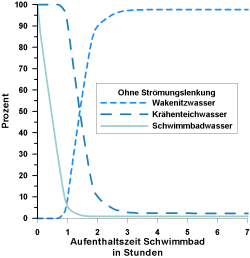Results
The model studies focussed on the engineering measures to control
the current regime by means of a training wall revealed that
those measures were not that effective to improve the swimming
water quality in the swimming bath area. The exchange of water
in the swimming bath caused by the training wall was only quite
small.
However, another technical
measure, the complete opening
of the inlet for a short time period of two hours was more
successful. This measure causes
an almost complete water
exchange (80 %).
 |
 |
| Figure: Calculated
residence time within the
Krähenteich with a completely
opened culvert. |
Figure: Calculated
residence time only for
the swimming area also
with a completely opened culvert. |
Conclusions for the model studies:
The amount of in and out flowing water masses is controlling
and dominating the resi-dence
time in the Krähen- and Mühlenteich
system.
The wind impact in general causes mixing and resuspension of
particles.
The shifting of the outlet to the turbine of the water power
plant causes slower currents
and a longer residence time
in the south-eastern part
of the Mühlenteich.
The water quality in the swimming area of the Krähenteich
can be improved markedly
by a short (2 hours) flushing
controlled by a complete
opening of the culvert (7.1
m³/s).
The technical measure – construction of a training
wall within the Krähenteich – revealed no significant
improvement in water exchange and resulting water quality
for the bathing area.


